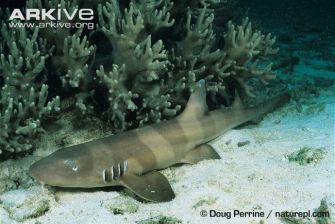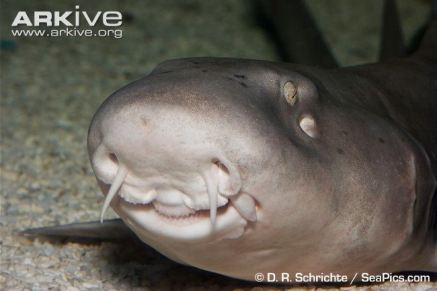Not all sharks spend their lives in the deep, open waters of the ocean. Some sharks prefer the shallows. You will find a small shark called Brown Banded Bamboo Shark (Chiloscyllium punctatum) in the tropical waters of the Indo-West Pacific. Only reaching about 3.5 feet in length, they can be spotted hiding out in crevices of coral reefs, along sandy and muddy substrates. There are even accounts of this shark residing in tidepools! What special adaptations do these sharks have that allow them to survive in these habitats?
 Like many creatures in inhabiting diverse ecosystems, one special attribute of this shark is its coloration and pattern. The young will have “bands” across its body while the adults are light brown. This allows the species to camouflage with the shadows cast by its surroundings. Their camouflage protects them from predators and masks their presence to unsuspecting prey. When the bamboo shark feeds, it creeps out of its hiding place at night and kicks up the sand, shocking and blinding its prey. They feed on bottom-dwelling (remember that word “benthic”?) organisms and small fish.
Like many creatures in inhabiting diverse ecosystems, one special attribute of this shark is its coloration and pattern. The young will have “bands” across its body while the adults are light brown. This allows the species to camouflage with the shadows cast by its surroundings. Their camouflage protects them from predators and masks their presence to unsuspecting prey. When the bamboo shark feeds, it creeps out of its hiding place at night and kicks up the sand, shocking and blinding its prey. They feed on bottom-dwelling (remember that word “benthic”?) organisms and small fish.
Another useful adaptation is the ability to survive in water with low oxygen levels. This phenomenon is known as environmental hypoxia. It is vital for creatures that live in an environment where the levels of dissolved oxygen can become so low that it cannot support aquatic life, as is often the case in tidepools. Tidepools are formed as the tide goes out and pools of water get trapped in crevices in and between rocks. This happens twice a day. The sun warms the pools causing evaporation and a decrease in oxygen. The organisms living in these pools use up the existing oxygen and those with various adaptations, like our bamboo shark are able to survive. Now that’s pretty amazing!
Join us next week as we look at a relative of the bamboo shark.
References:
Edited by KC O’Shea
Photography: Pictures from ARKIVE– D.R Schrichte and Doug Perrine
http://www.flmnh.ufl.edu/fish/Gallery/Descript/bbambooshark/bbambooshark.html
Bennett, M.B. & Kyne, P.M. (SSG Australia & Oceania Regional Workshop, March 2003) 2003. Chiloscyllium punctatum. The IUCN Red List of Threatened Species. Version 2015.2. <www.iucnredlist.org>. Downloaded on 29 July 2015.


Leave a comment